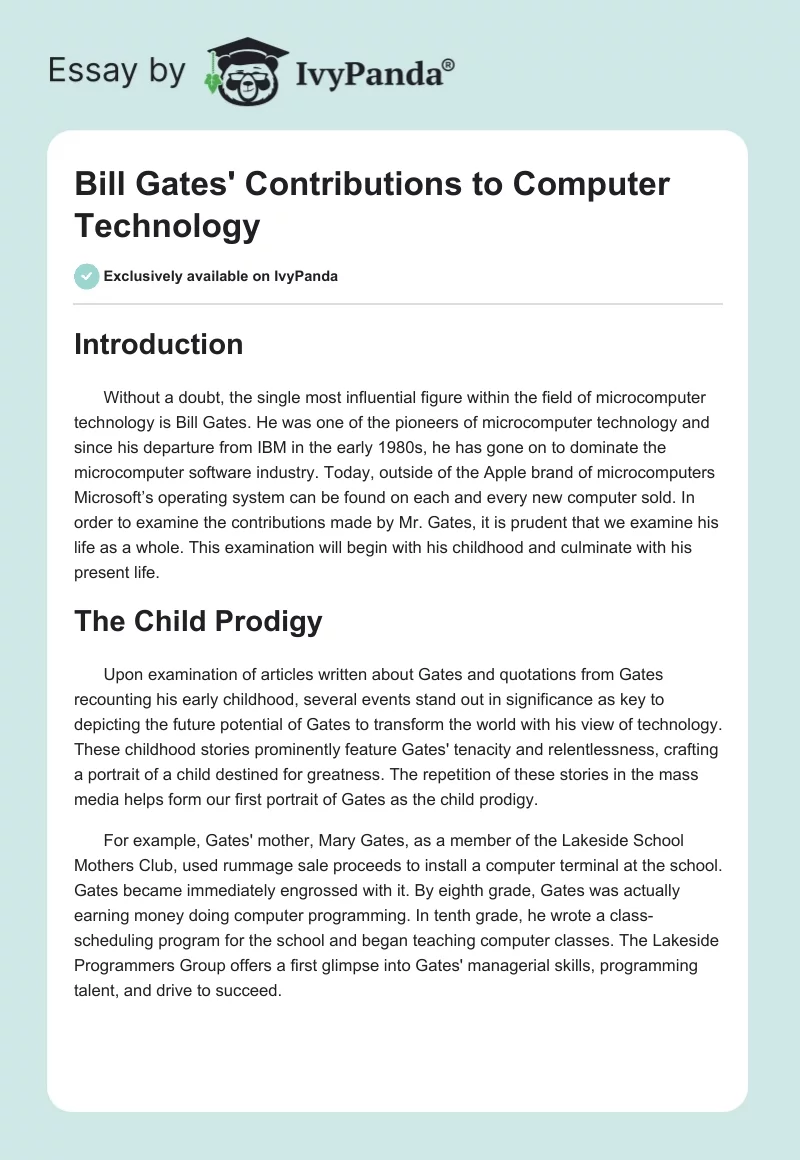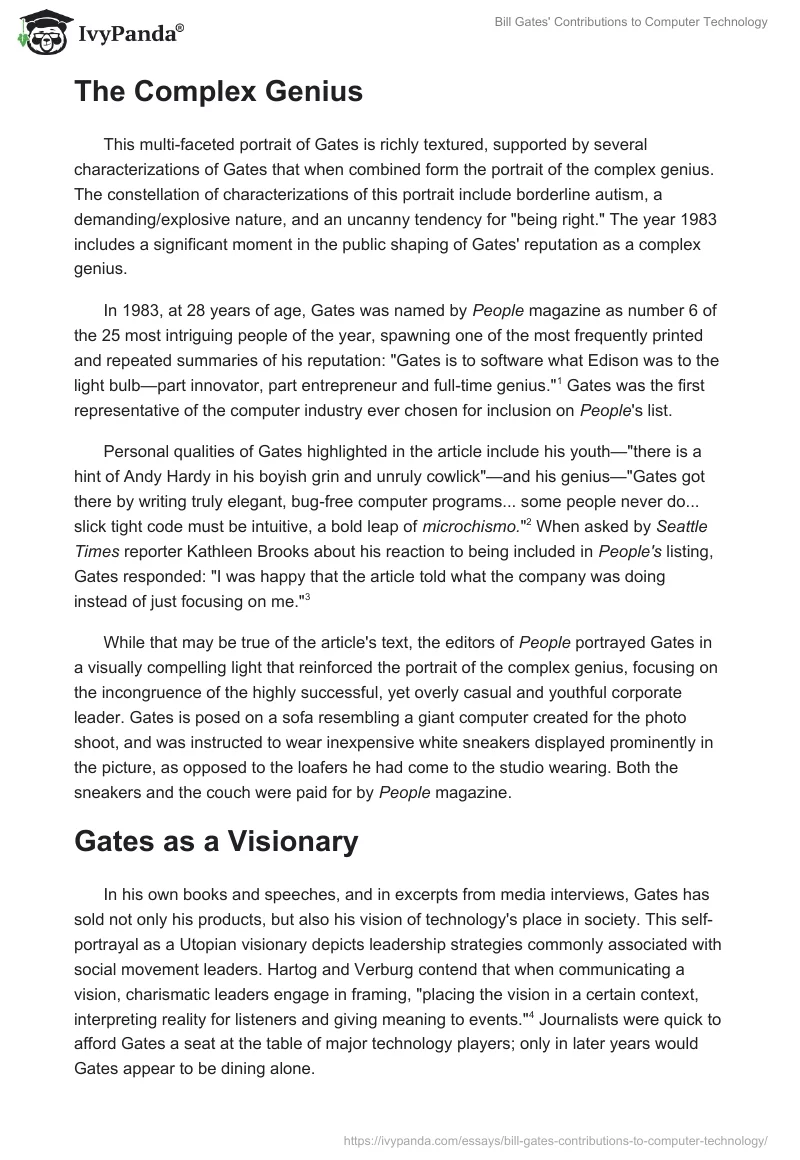Introduction
Without a doubt, the single most influential figure within the field of microcomputer technology is Bill Gates. He was one of the pioneers of microcomputer technology and since his departure from IBM in the early 1980s, he has gone on to dominate the microcomputer software industry. Today, outside of the Apple brand of microcomputers Microsoft’s operating system can be found on each and every new computer sold. In order to examine the contributions made by Mr. Gates, it is prudent that we examine his life as a whole. This examination will begin with his childhood and culminate with his present life.
The Child Prodigy
Upon examination of articles written about Gates and quotations from Gates recounting his early childhood, several events stand out in significance as key to depicting the future potential of Gates to transform the world with his view of technology. These childhood stories prominently feature Gates’ tenacity and relentlessness, crafting a portrait of a child destined for greatness. The repetition of these stories in the mass media helps form our first portrait of Gates as the child prodigy.
For example, Gates’ mother, Mary Gates, as a member of the Lakeside School Mothers Club, used rummage sale proceeds to install a computer terminal at the school. Gates became immediately engrossed with it. By eighth grade, Gates was actually earning money doing computer programming. In tenth grade, he wrote a class-scheduling program for the school and began teaching computer classes. The Lakeside Programmers Group offers a first glimpse into Gates’ managerial skills, programming talent, and drive to succeed.
The Complex Genius
This multi-faceted portrait of Gates is richly textured, supported by several characterizations of Gates that when combined form the portrait of the complex genius. The constellation of characterizations of this portrait includes borderline autism, a demanding/explosive nature, and an uncanny tendency for “being right.” The year 1983 includes a significant moment in the public shaping of Gates’ reputation as a complex genius.
In 1983, at 28 years of age, Gates was named by People magazine as number 6 of the 25 most intriguing people of the year, spawning one of the most frequently printed and repeated summaries of his reputation: “Gates is to software what Edison was to the light bulb—part innovator, part entrepreneur, and full-time genius.” Gates was the first representative of the computer industry ever chosen for inclusion on People‘s list.
Personal qualities of Gates highlighted in the article include his youth—”there is a hint of Andy Hardy in his boyish grin and unruly cowlick”—and his genius—”Gates got there by writing truly elegant, bug-free computer programs… some people never do… slick tight code must be intuitive, a bold leap of microchips.” When asked by Seattle Times reporter Kathleen Brooks about his reaction to being included in People’s listing, Gates responded: “I was happy that the article told what the company was doing instead of just focusing on me.”
While that may be true of the article’s text, the editors of People portrayed Gates in a visually compelling light that reinforced the portrait of the complex genius, focusing on the incongruence of the highly successful, yet overly casual and youthful corporate leader. Gates is posed on a sofa resembling a giant computer created for the photo shoot, and was instructed to wear inexpensive white sneakers displayed prominently in the picture, as opposed to the loafers he had come to the studio wearing. Both the sneakers and the couch were paid for by People magazine.
Gates as a Visionary
In his own books and speeches, and in excerpts from media interviews, Gates has sold not only his products but also his vision of technology’s place in society. This self-portrayal as a Utopian visionary depicts leadership strategies commonly associated with social movement leaders. Hartog and Verburg contend that when communicating a vision, charismatic leaders engage in framing, “placing the vision in a certain context, interpreting reality for listeners and giving meaning to events.” Journalists were quick to afford Gates a seat at the table of major technology players; only in later years would Gates appear to be dining alone.
In a 1980 article in On Computing magazine, author Chris Morgan writes that “We recently took some time to look into a crystal ball with two of the leading experts in personal computing software, Bill Gates and Dan Flystra.” Gates is characterized simply as “the young President of Microsoft, Inc.” Gates speaks authoritatively about the future direction of the computer industry. In response to the question, “do you have a general feel for where the market is going in the 1980s?” Gates responds that in the future, software will define the personal computer. He predicted that the cost of computer hardware would plummet, and that software would become the determining factor in the computer industry’s success.
The 1981 Seattle Business Journal article attributes Gates’ success to his childhood fascination with computers and his uncanny timing. It summarizes the highlights of Gates’ childhood, beginning with the story of the Lakeside school and its early exposure to computers for the students, and reaching its apex in Gates’ and Allen’s ability to accurately predict the future: “A tiny silicon chip with microscopic circuits was responsible for a technological revolution—a revolution Gates and Allen could anticipate.” Once again, we see how the reputation portraits are not distinct, but rather work together to reinforce Gates’ various public images. Yet in combination, the childhood prodigy, complex genius, and secular prophet reputation-portraits function to portray Gates as a uniquely qualified technology industry leader.
Gates as a Flawed Hero
No one can doubt the propensity of Mr. Gates to appear as an imperfect individual. In fact his moral character has been called to question when he obtained the work product of IBM, the company he worked for at the time when IBM dominated the personal computer operating system market. The first instance of Gates as a flawed hero is found in the delay of the highly-hyped product, Microsoft Windows. At New York’s Plaza Hotel on November 10, 1983 Gates announced the newest addition to the Microsoft family of software products: Microsoft Windows. The delivery date was to be May 1984.
With its graphical interface and capability to see multiple “windows” open simultaneously, this new operating system was hyped as being a milestone for ushering computers into the non-specialist arena. However, the product did not actually make it to market until July 1985. The press characterized this delay as the first major embarrassment for Microsoft. In a 1984 InfoWorld editorial, computer industry professional Stewart Alsop wrote that Microsoft “seems to have fallen into a bad habit with Windows. Announce, show, promise, and delay. Then delay some more.”
A second embarrassment for Gates and Microsoft comes from their lackluster performance in the computer games market. MSX, a Microsoft-designed operating system made especially for game-oriented computer enthusiasts was poorly received at the Winter Consumer Electronics Show in January 1985. A Seattle Times article characterized MSX as “dead technology,” and quoted an Info World column labeling MSX “the Pong of the 1980s.” Though this article did not mention Gates specifically, still it had a negative impact on his image. After all, Gates and Microsoft are so intimately connected that the tarnishing of one reputation necessarily impacts the other.
Further, when a company has experienced the phenomenal business success Microsoft enjoyed in its first few years, the media is always ready to find fault. For example, an August 1985 article in The Seattle Times detailed Microsoft’s fiscal sales as growing 44 percent to $140 million, but characterized this growth as “a sign that the company isn’t growing quite as fast as it did in the past eight years.” At the same time as the company began experiencing its first taste of failure, they also began reaching out directly to consumers—perhaps in response to their brush with negative publicity.
Bibliography
Brooks, Kathleen. “Microsoft’s Bill Gates Is People’s Choice.” The Seattle Times, 1984.
Buck, Richard. “Hard Going for Microsoft. Trade Show Is Cool toward Machines with Microsoft Systems,” The Seattle Times, 1985.
“Dropping out of Harvard Pays Off for a Computer Whiz Kid Who’s Making Hard Cash from Software.” People Weekly, 1984, 36-37.
Hartog, Deanne. “Charisma and Rhetoric: Communicative Techniques of International Business Leaders.” Leadership Quarterly 8 (1997): 355-391.
Manes, Stephen, and Paul Andrews. Gates: How Microsoft’s Mogul Reinvented an Industry and Made Himself the Richest Man in America. New York: Simon and Schuster, 1994.
Morgan, Chris. “Software in the 80s: Two Interviews.” On Computing, Fall 1980, 36-39.


